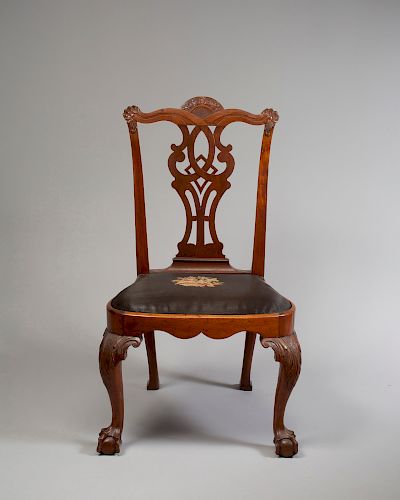SIR WILLIAM JOHNSON'S IMPORTANT CHIPPENDALE MAHOGANY COMPASS SEAT SIDE CHAIR,New York, 1770-1765
Lot 4
About Seller
Keno Auctions
127 East 69th Street
New York, NY 10021
United States
Keno Auctions is renowned for our expertise in fine and decorative arts. With more than 30 years experience, founder Leigh Keno has established a brilliant team of experts specializing in fine art, furniture, decorative arts and jewelry.
Categories
Estimate:
$25,000 - $50,000
Absentee vs Live bid
Two ways to bid:
- Leave a max absentee bid and the platform will bid on your behalf up to your maximum bid during the live auction.
- Bid live during the auction and your bids will be submitted real-time to the auctioneer.
Bid Increments
| Price | Bid Increment |
|---|---|
| $0 | $25 |
| $100 | $100 |
| $2,000 | $250 |
| $5,000 | $500 |
| $30,000 | $2,500 |
| $50,000 | $5,000 |
| $100,000 | $10,000 |
| $500,000 | $10,000 |
| $1,000,000 | $10,000 |
About Auction
By Keno Auctions
Jan 24, 2020
Set Reminder
2020-01-24 15:00:00
2020-01-24 15:00:00
America/New_York
Bidsquare
Bidsquare : Important Americana – Featuring Furniture and Folk Art from a Distinguished NY Collection
https://www.bidsquare.com/auctions/keno/important-americana-featuring-furniture-and-folk-art-from-a-distinguished-ny-collection-4838
Keno Auctions Leigh@kenoauctions.com
Keno Auctions Leigh@kenoauctions.com
- Lot Description
The crest rail with a diapered lunette with c-scrolls and cabochons, crosshatching and ruffled carving, flanked by wavy shell-carved ears, the New York diamond and scrolled splat above a balloon seat with cyma-curved lower front edge, above boldly projected frontal cabriole legs with acanthus leafage and crosshatching and ending in claw-and-ball feet, the slightly raked rear legs ending in a squared foot. This previously unpublished side chair is part of a well- known set of at least nine. According to long standing tradition, the set was originally owned by Sir William Johnson (1715-1774), Johnstown, New York, Superintendent of Indian Affairs for the Northern Colonies. We purchased the chair from the direct descendant of Abraham Gerretson (later spelled Garrison, who married Mary Brower June 5, 1761 at Stone Arabia Church) who, according to family tradition, purchased five chairs at the auction of the confiscated effects of Sir William Johnson. For a 19th century account of the purchase and descent of the set please see Washington Frothingham's History of Montgomery County, (Syracuse, 1892), p. 240. The inventory of Sir William Johnson's Estate, after his death on July 11, 1774 listed "Furniture in Blue Parlor" and included "6 mahog. cheek bottom chairs. . .3. . .[pounds]". Documents show that Johnson purchased several items in Manhattan. Joseph Downs refers to an entry of Nov. 6, 1760, in the Martin Van Bergen account books: "To Wm Johnson to freight 6 chairs L0.6.0" from Manhattan. In 2010, it became clear that Brookman’s shop had created some of the finest furniture in the Colonies. While researching a masterpiece-level carved Mahogany Dressing Chest with dressing slide which had descended directly to the consignor from the young, wealthy merchant, James Beekman (1732-1807). The discovery by Mr. Keno of both this elaborately carved dressing chest and its unexpected listing in the James Beekman account books at The New York Historical Society show clearly that Beekman acquired a large quantity of expensive furniture from Thomas Brookman over a decade before the Johnson chairs were made and shipped up to Johnstown. Listed on the 1st page of his account book, Nov. 15, 1752, for the princely sum of £16. At our 2010 Sale, the chest sold for a record $1.4M. Six other chairs from the set are in the collections of Winterthur (a pair, see Joseph Downs', American Furniture: Queen Anne and Chippendale Periods, New York, 1952, fig. 149; Philip Flayderman Sale, 1930, lot 447), Bayou Bend (see David B. Warren's Bayou Bend - American Furniture, Paintings and Silver from the Bayou Bend Collection, Houston, 1975, pg. 46, no. 77), Yale (see Patricia E. Kane's 300 Years of American Seating Furniture: Chairs and Beds from The Mabel Brady Garvan and other Collections at Yale University, Boston, 1976, pp. 121-123, no. 102 and John T. Kirk's, American Chairs; Queen Anne and Chippendale, New York, 1972, pg.120, fig. 143), Chipstone Foundation (see Oswaldo Rodriguez Rogue's American Furniture at Chipstone, Wisconsin, 1984, pp. 128-129, no. 55) and The Minneapolis Institute of Art (acc. no. 31.15.12. Dimensions: H. 39 1/2 in., W. 23 in., D. 22 in. Provenance: Abraham Gerretson (later spelled Garrison, m. Mary Brower June 5, 1761 at Stone Arabia Church) Maria Gerretson (b. Sept. 17, 1769 - d. April 17, 1835), m. Abraham Newkirk (1762-1830) Maria Newkirk (b. April 23, 1801), m. Harmanus Mabee Peter Mabee (b. June 15, 1838) Mary Mabie, m. Benjamin Faulkner Edwin Faulkner, m. Cornelia Allen Lutitia Faulkner, m. Washburn Shutts Thence by descent to the previous owner Leigh Keno American Furniture, May, 1992 Present ownersThe surface has been cleaned (sometime in the 1960's according to the prior owner). The chair is numbered VIIII on the front seat rail and the slip seat frame is numbered VIIII. The red oak seat frame retains its original muslin, stuffing and webbing. The horsehair-woven with polychrome central floral medallion needlework embroidered cover is mid-19th century. The exact same cover is pictured on the seat of the chair sold in the Philip Flayderman sale (now at Winterthur) and on the chair in the Garvan Collection at Yale University. Tack evidence, etc. shows that this cover was probably put on in the mid-19th century. There is a minor old crack at the top of the right stile. Two small pieces of red wool cover upholstery remains under two early tacks. A photograph of the chair taken in the 1950's shows it with an old finish. The dependent short leaves at the top of each stile were missing and E. C. Rios Restoration replaced these in May of 1992. The original chisel marks outlining the leaves remain. Old breaks on both the upper right and left stiles. The knee returns to the left of the front left leg and to the right of the front right leg are replaced. Small patch to rear left leg at the juncture of the leg and lower seat rail. The white pine front glue blocks are original.
Condition
- Shipping Info
-
Buyer Pays Shipping Cost
-
- Buyer's Premium



 EUR
EUR CAD
CAD AUD
AUD GBP
GBP MXN
MXN HKD
HKD CNY
CNY MYR
MYR SEK
SEK SGD
SGD CHF
CHF THB
THB























